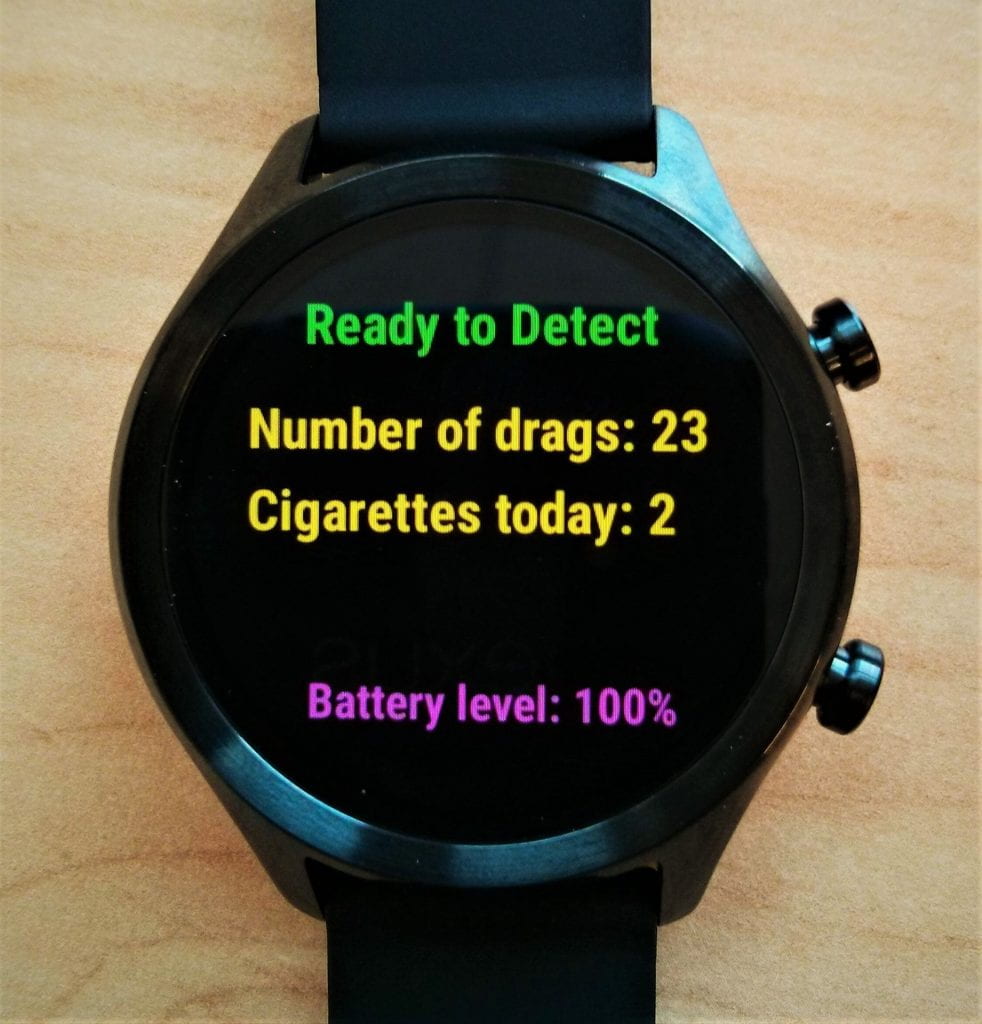
 Dr Andy Skinner and Chris Stone
Dr Andy Skinner and Chris Stone
Follow Andy and Chris on twitter
October sees the return of Stoptober, a Public Health England initiative to encourage smokers to quit. Campaigns like this and many others have been effective in reducing smoking in the UK over a number of decades. However, on average, about 15% of the UK’s population still smoke, and this costs the NHS more than £2.5bn each year.
To help address this, the NHS Long Term Plan has identified a range of measures to encourage healthier behaviours, including the need to speed up the introduction of innovative new health interventions based on digital technologies.
Here in the MRC IEU we’ve been working on a new wearable system that could help people stop smoking; stopWatch is a smartwatch-based system that automatically detects cigarette smoking. Because the system can detect when someone is smoking a cigarette, it can trigger the delivery of interventions to help that person quit smoking at precisely the time the interventions will be most effective.

What is stopWatch, and how does it work?
stopWatch is an application that runs on a commercially available Android smartwatch. Smartwatches now come equipped with motion sensors, just like the ones in smartphones that measure step counts and activity levels. As smartwatches are attached to the wrist, the motion sensors in a smartwatch can tell us how a person’s hand is moving. stopWatch takes data from the smartwatch’s motion sensors and applies machine learning methods to look for the particular pattern of hand movements that are unique to smoking a cigarette.
How can we use stopWatch to help people quit smoking?
It’s estimated about a third of UK smokers try to stop each year, but only a fifth of those that try manage to succeed. For most smokers an attempt to stop smoking ends with a lapse (having just one cigarette), that can quickly lead to a full relapse to smoking. As stopWatch can detect the exact moment a smoker lapses and has a cigarette, it can trigger the precise delivery of an intervention aimed specifically at helping prevent the lapse turning into a full relapse back to smoking.
Will the intervention work?
A recent article highlighted the potential for using mobile and wearable technologies, like stopWatch, to deliver these kinds of ‘just-in-time’ interventions for smoking. To develop our smoking relapse intervention we will be using the person-based approach, which has an excellent track record of delivering effective health behaviour change interventions. We will also be engaging the highly interdisciplinary cohort of PhD students in the new EPSRC Center for Doctoral Training in Digital Health and care, which brings together students with backgrounds in health, computer science, design and engineering.
However, that same article also pointed out that these types of intervention are still new, and that there has been little formal evaluation of them so far. So we don’t yet know how effective these will be, and it’s important interventions of this kind are subject to a thorough evaluation.
We will be working closely with colleagues in NIHR’s Applied Research Collaboration (ARC) West and Bristol Biomedical Research Centre who have expertise in developing, and importantly, evaluating interventions. We will also be working with the CRUK-funded Integrative Cancer Epidemiology Unit at the University of Bristol, collaborating with researchers who have detailed knowledge of developing interventions for specific patient groups.

How good is stopWatch at detecting cigarette smoking?
In any system designed to recognise behaviours there is a trade-off between performance and cost/complexity. Other systems that use wearables to detect smoking are available, but these require the wearable be paired with a smartphone and need a data connection to a cloud-based platform in order to work properly. stopWatch is different in that it runs entirely on a smartwatch. It doesn’t need to be paired with a smartphone, and doesn’t need a data connection. This makes it cheaper and simpler than the other systems, but this also means its performance isn’t quite as good.
We recently validated the performance of stopWatch by asking thirteen participants to use stopWatch for a day as they went about their normal lives. On average, stopWatch detected 71% of cigarettes smoked (the system’s sensitivity), and of the events stopWatch thought were cigarette smoking, 86% were actually cigarette smoking (its specificity). This compares with a sensitivity of 82% and specificity of 97% for the systems that require smartphones and data networks.
When will stopWatch and the smoking relapse intervention be available and what will they cost?
The stopWatch system itself is available for research purposes to academic partners now, free of charge. We’re open to discussions with potential commercial partners – please get in touch if you’d like to discuss this (contact details below).
We aim to begin work on the smoking relapse intervention based on stopWatch next year, and we expect development and evaluation to take between 18 and 24 months. The cost of the intervention has yet to be determined. That will depend on many factors, including the partnerships we form to take the intervention forward.
What’s next?
We’re currently putting stopWatch through its paces in some tough testing in occupational settings. This will stress the system so that we can identify any weaknesses, find out to how to improve the system, and develop recommendations for optimising the use of stopWatch in future studies and interventions.
We’re also developing a new smartwatch-based system for the low burden collection of self-report data called ‘dataWatch’. This is currently undergoing feasibility testing in the Children of the 90s study.
Contact the researchers
Dr Andy Skinner Andy.Skinner@bristol.ac.uk
